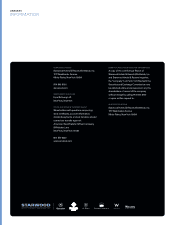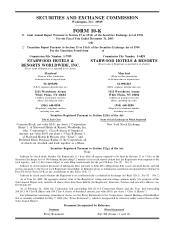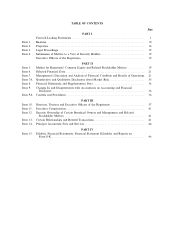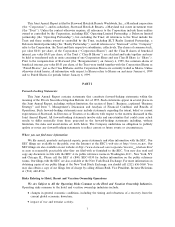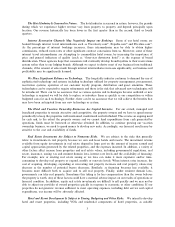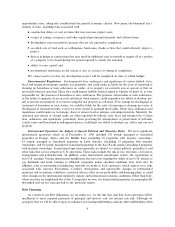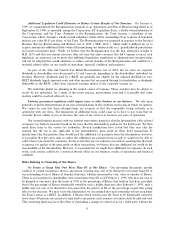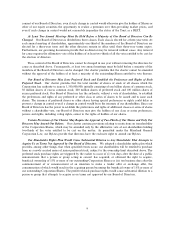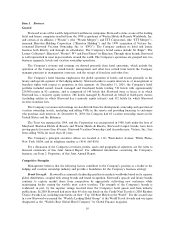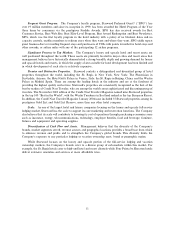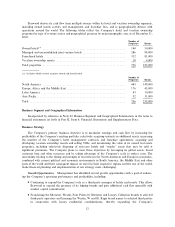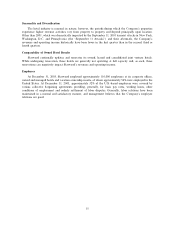Starwood 2003 Annual Report Download - page 15
Download and view the complete annual report
Please find page 15 of the 2003 Starwood annual report below. You can navigate through the pages in the report by either clicking on the pages listed below, or by using the keyword search tool below to find specific information within the annual report.it matures, there can be no assurance that we will be able to do so or that the terms of such reÑnancings will be
favorable. Our leverage may have important consequences including the following: (i) our ability to obtain
additional Ñnancing for acquisitions, working capital, capital expenditures or other purposes, if necessary, may
be impaired or such Ñnancing may not be available on terms favorable to us; (ii) a substantial decrease in
operating cash Öow or an increase in our expenses could make it diÇcult for us to meet our debt service
requirements and force us to sell assets and/or modify our operations; and (iii) our higher level of debt and
resulting interest expense may place us at a competitive disadvantage with respect to certain competitors with
lower amounts of indebtedness and/or higher credit ratings. On May 6, 2003, Standard & Poor's announced
its decision to downgrade the Company's Credit Rating to BB° (non-investment grade with a stable outlook)
from BBB¿ (investment grade rating on Credit Watch with negative implications). On January 7, 2004,
Moody's Investor Services and Standard & Poor's placed the Company's Ba1 and BB° corporate credit
ratings on review/watch for a possible downgrade. The review/watch was prompted by the Company's
announcement that it had invested $200 million in Le Meridien Hotels and Resorts Ltd. (""Le Meridien'')
senior debt and would be in discussions to negotiate the potential recapitalization of Le Meridien. The
downgrading of the Company's credit rating may result in higher borrowing costs on future Ñnancings and
impact our ability to access capital markets.
Risks Relating to So-Called Acts of God, Terrorist Activity and War
Our Ñnancial and operating performance may be adversely aÅected by so-called acts of God, such as
natural disasters, in locations where we own and/or operate signiÑcant properties and areas of the world from
which we draw a large number of customers. Similarly, wars (including the potential for war), terrorist activity
(including threats of terrorist activity), political unrest and other forms of civil strife and geopolitical
uncertainty have caused in the past, and may cause in the future, our results to diÅer materially from
anticipated results.
Some Potential Losses are Not Covered by Insurance
We carry comprehensive insurance coverage for general liability, property, business interruption and
other risks with respect to our owned and leased properties and we make available insurance programs for
owners of properties we manage and franchise. These policies oÅer coverage features and insured limits that
we believe are customary for similar type properties. Generally, our ""all-risk'' property policies provide that
coverage is available on a per occurrence basis and that, for each occurrence, there is a limit as well as various
sub-limits on the amount of insurance proceeds we can receive. In addition, there may be overall limits under
the policies. Sub-limits exist for certain types of claims such as service interruption, abatement, expediting
costs or landscaping replacement, and the dollar amounts of these sub-limits are signiÑcantly lower than the
dollar amounts of the overall coverage limit. Our property policies also provide that for the coverages of
critical earthquake (California and Mexico) and Öood, all of the claims from each of our properties resulting
from a particular insurable event must be combined together for purposes of evaluating whether the annual
aggregate limits and sub-limits contained in our policies have been exceeded and any such claims will also be
combined with the claims of owners of managed hotels that participate in our insurance program for the same
purpose. Therefore, if insurable events occur that aÅect more than one of our owned hotels and/or managed
hotels owned by third parties that participate in our insurance program, the claims from each aÅected hotel
will be added together to determine whether the annual aggregate limit or sub-limits, depending on the type of
claim, have been reached and if the limits or sub-limits are exceeded each aÅected hotel will only receive a
proportional share of the amount of insurance proceeds provided for under the policy. In addition, under those
circumstances, claims by third party owners will reduce the coverage available for our owned and leased
properties.
In addition, there are also other risks such as war, certain forms of terrorism such as nuclear, biological or
chemical terrorism, acts of God such as hurricanes and earthquakes and some environmental hazards that
may be deemed to fall completely outside the general coverage limits of our policies or may be uninsurable or
may be too expensive to justify insuring against.
5



